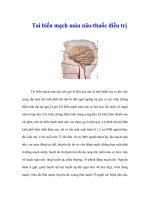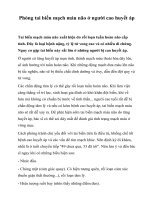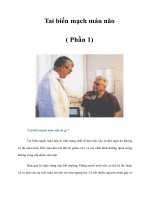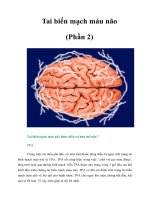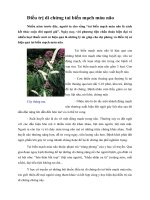Tai biến mạch máu não STROKE PGS TS nguyễn đình toàn
Bạn đang xem bản rút gọn của tài liệu. Xem và tải ngay bản đầy đủ của tài liệu tại đây (2.94 MB, 43 trang )
STROKE
TAI BIẾN MẠCH MÁU NÃO
ThS Nguyễn Đình Toàn
ĐỊNH NGHĨA
Definition Of Stroke
• “Rapidly developed clinical sign of focal
disturbance of cerebral function of
presumed vascular origin and of more
than 24 hours” WHO
• TIA (Transient Ischaemic Attack)
recovery is complete within 24 hours.
10% of patients will go on to have a
stroke.
CƠ SỞ GIẢI PHẨU HỌC
DỊCH TỂ HỌC
• Stroke is the third largest killer in the
Western World.
• It accounts for up to 6% of in-patient
hospital costs in Scotland.
• Stroke is one of the major causes of
disability, particularly in the elderly.
• Stroke patients may present with a
variety of physical, cognitive and
psychosocial problems.
• Most stroke patients show signs of
recovery over time.
DỊCH TỂ HỌC
• Incidence
(WHO) 150-250/100.000 dân
Việt nam 20-35/100.000 dân
• prevalence (WHO) 500-700/100.000
dân
Việt nam 45-85/100.000 dân
Huế 61,60/100.000 dân
Mỹ: 750.000/năm
• Mortality 35-240/100.000 dân
• Chi phí điều trị > 60 tỷ dollars/năm (Mỹ)
Sub-types Of Stroke
• Ischaemic – obstruction to one of major
cerebral arteries, brainstem strokes are
less common.
• Haemorrhage – 9% are caused by
haemorrhage to the deep parts of the
brain. Patients are usually
hypertensive.
CƠ CHẾ BỆNH SINH
•Risk
Factors
•OBESIT
Y
DRUG ABUSE
• OLD AGE
• Wee Betty lived a
long and fruitfull
life, RIP Betty
(1875-1997).
That’s 122 years
don’t you know!
ALCOHOL
What are the symptoms?
If stroke effect CNS pathways, symptoms may include:
• muscle weakness (Hemiplegia)
• numbness
• reduction in sensory or vibratory sensation
If stroke effect the brainstem, symptoms may include:
• altered smell, taste, hearing, or vision (total or partial)
• drooping of eyelid and weakness of ocular muscles
• decreased reflexes: gag, swallow, pupil reactivity to light
• decreased sensation and muscle weakness of the face
• balance problems
• altered breathing and heart rate
• weakness in sternocleidomastoid muscle (SCM) with inability to turn head to one side
• weakness in tongue (inability to protrude and/or move from side to side)
If the cerebral cortex is involved, symptoms may include:
• aphasia (inability to speak or understand language from involvement of Broca's or
Wernicke's area)
• apraxia (altered voluntary movements)
• visual field cut(involvement of occipital lobe)
• memory deficits (involvement of temporal lobe)
• hemineglect (involvement of parietal lobe)
• disorganized thinking, confusion, hypersexual gestures (with involvement of frontal
lobe)
If the cerebellum is involved, symptoms may include:
• trouble walking
• altered movement coordination
• vertigo and or disequilibrium
CHẨN ĐOÁN XÁC ĐỊNH
• Dấu thần kinh khu trú
• Xảy ra đột ngột
• Không do chấn thương
